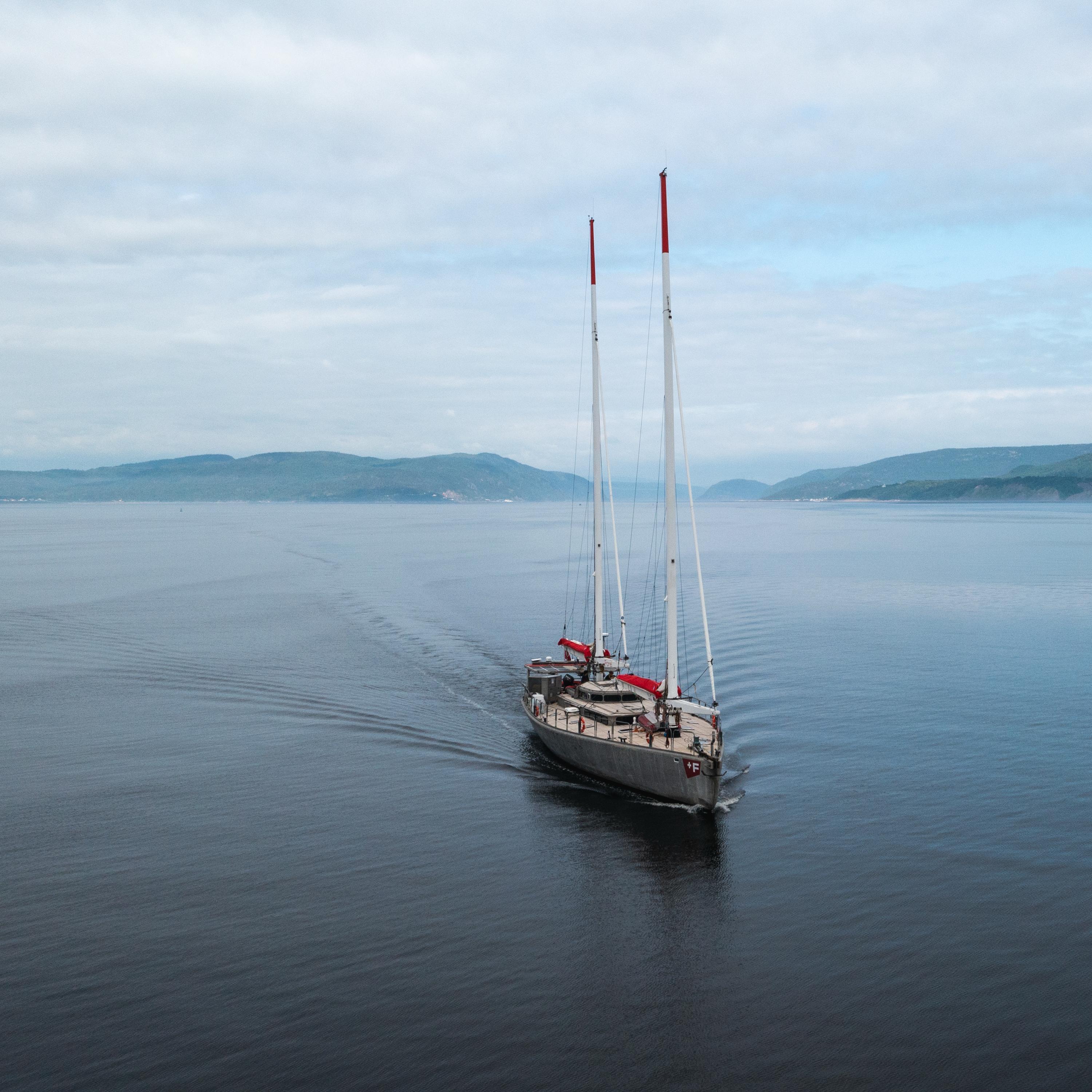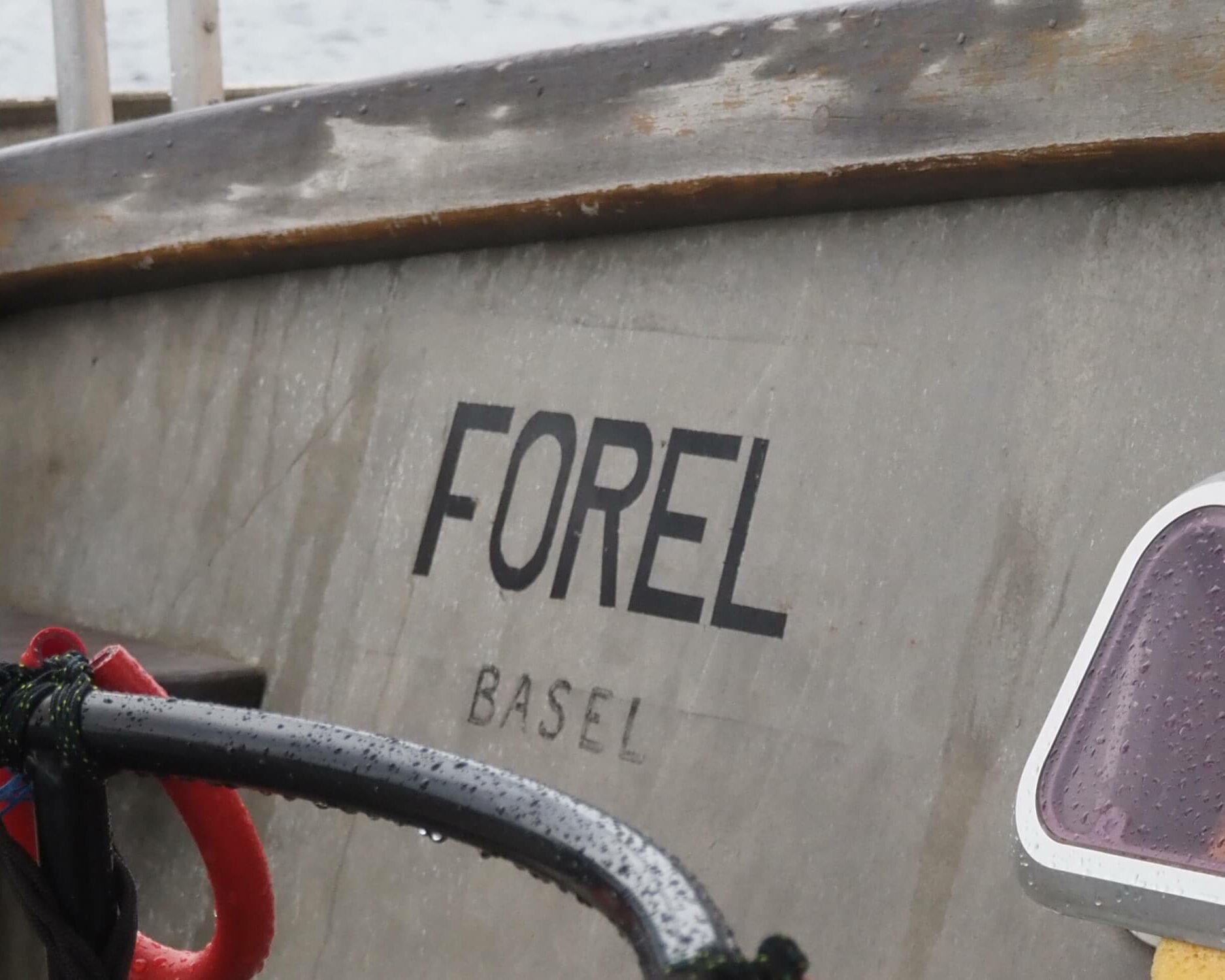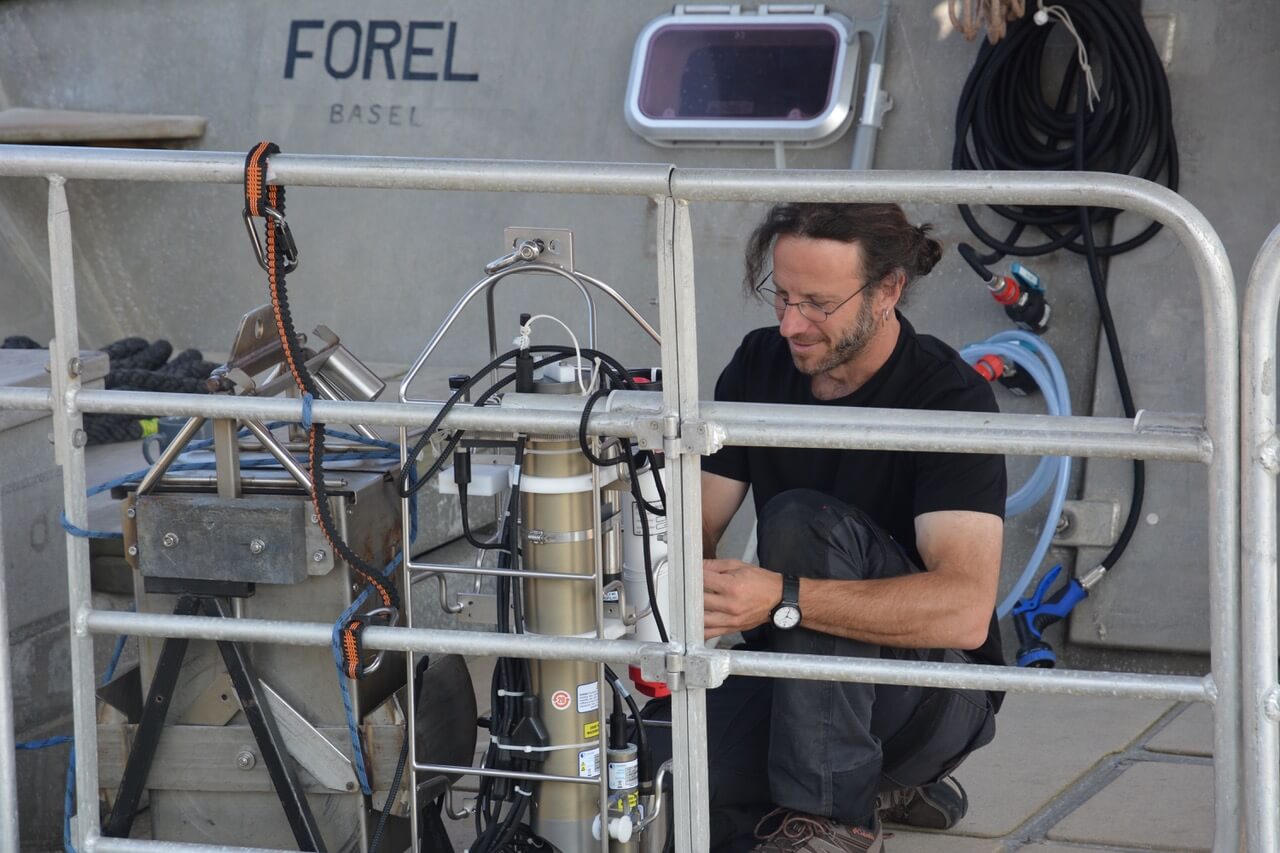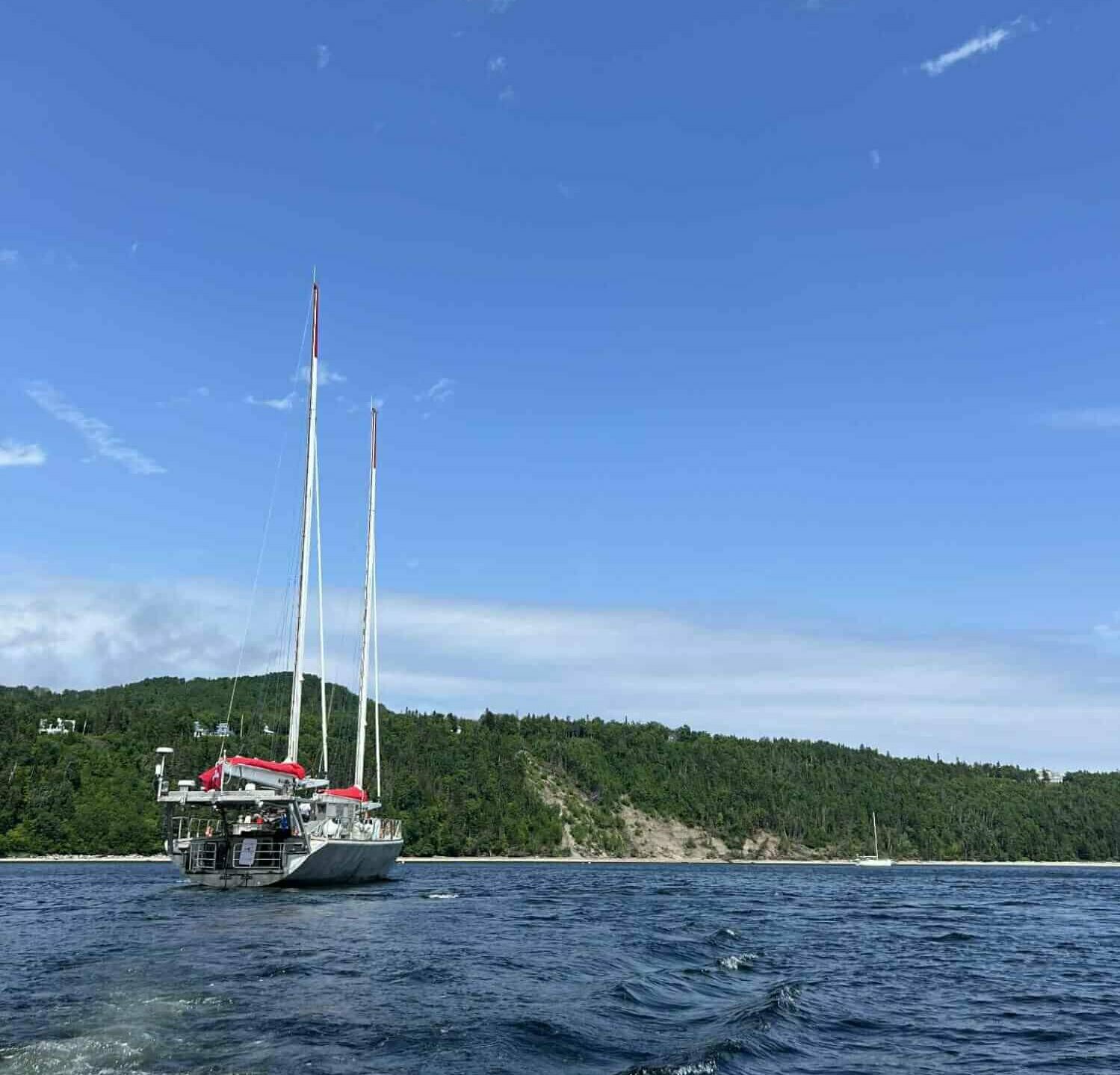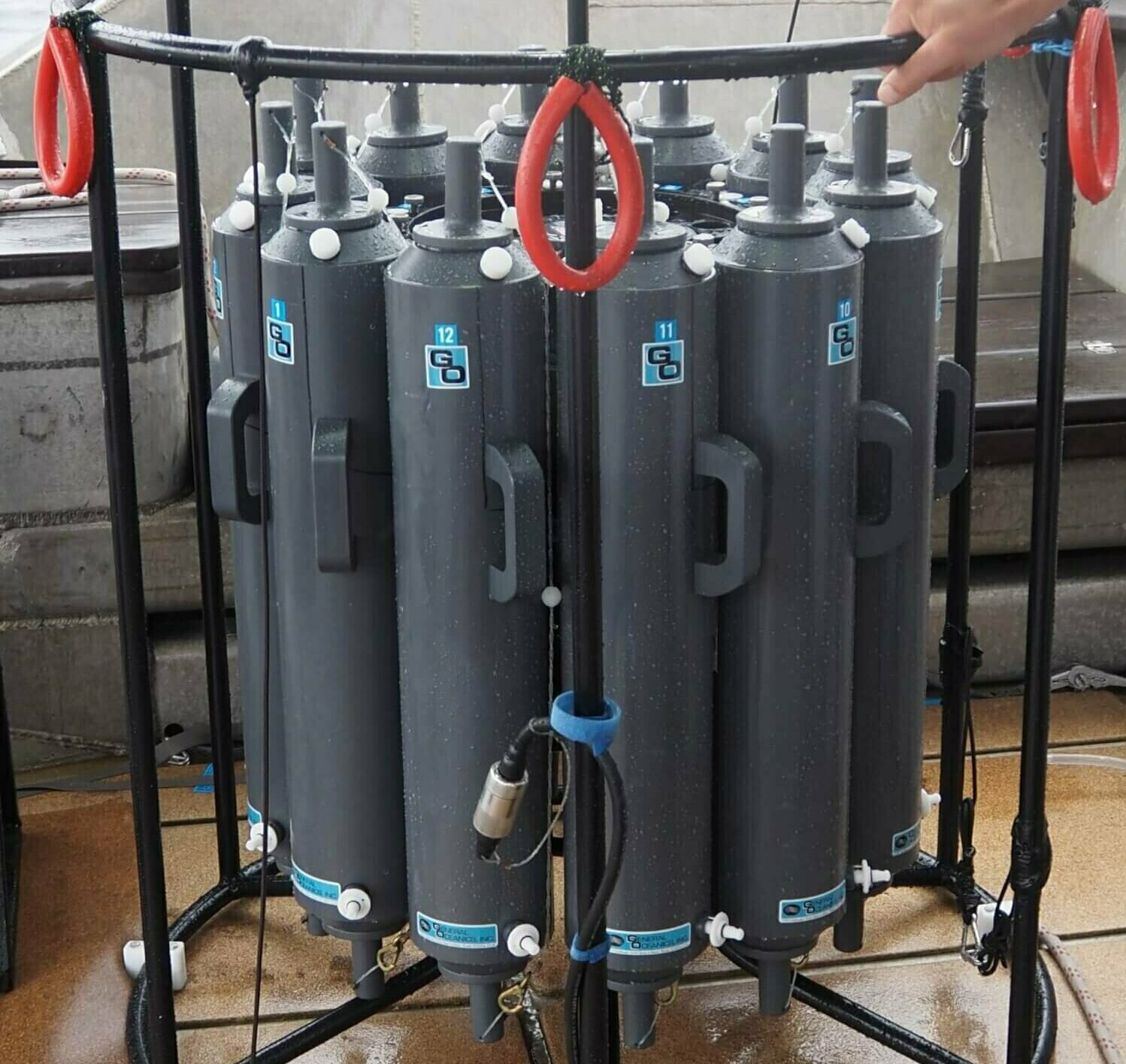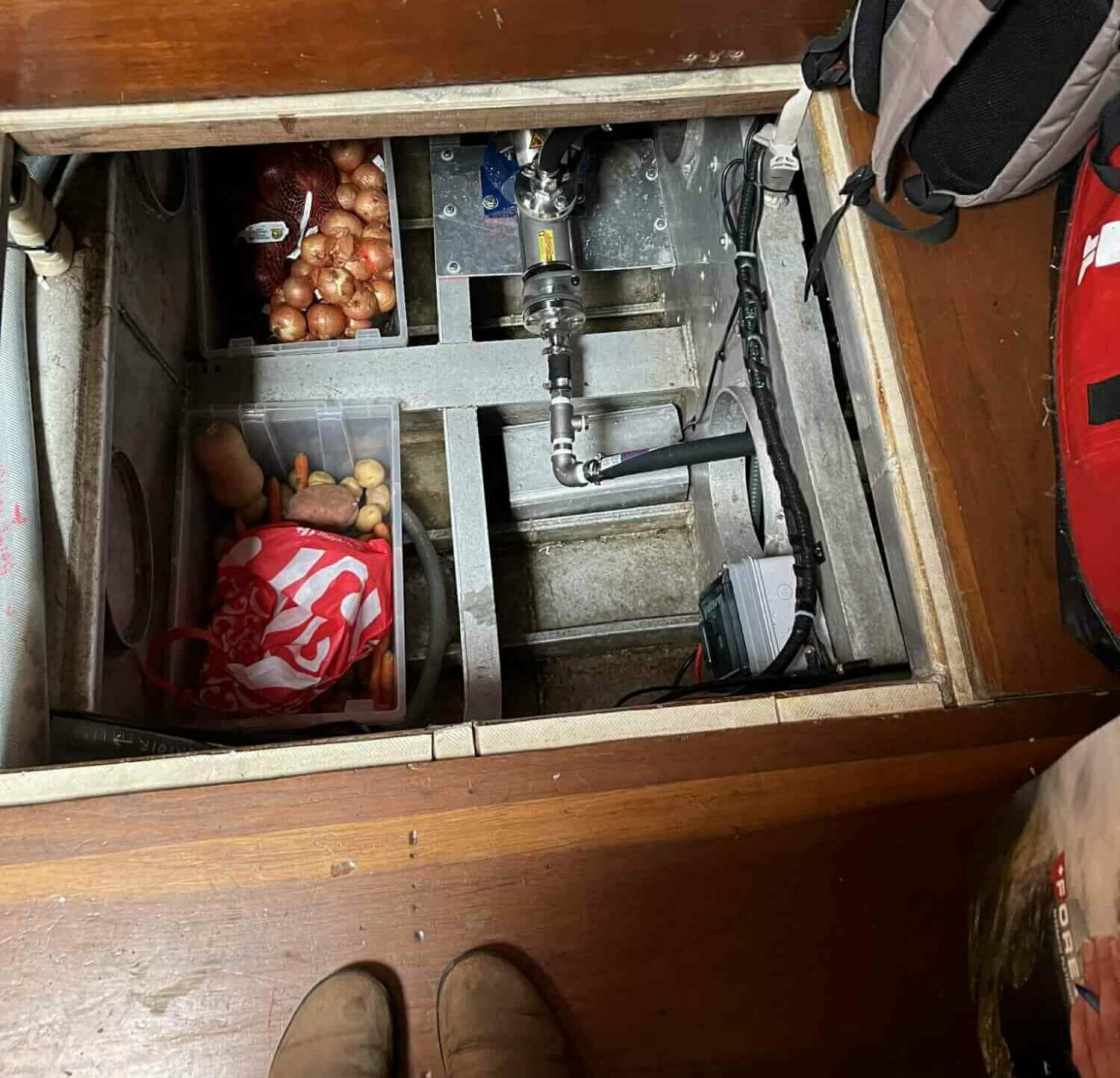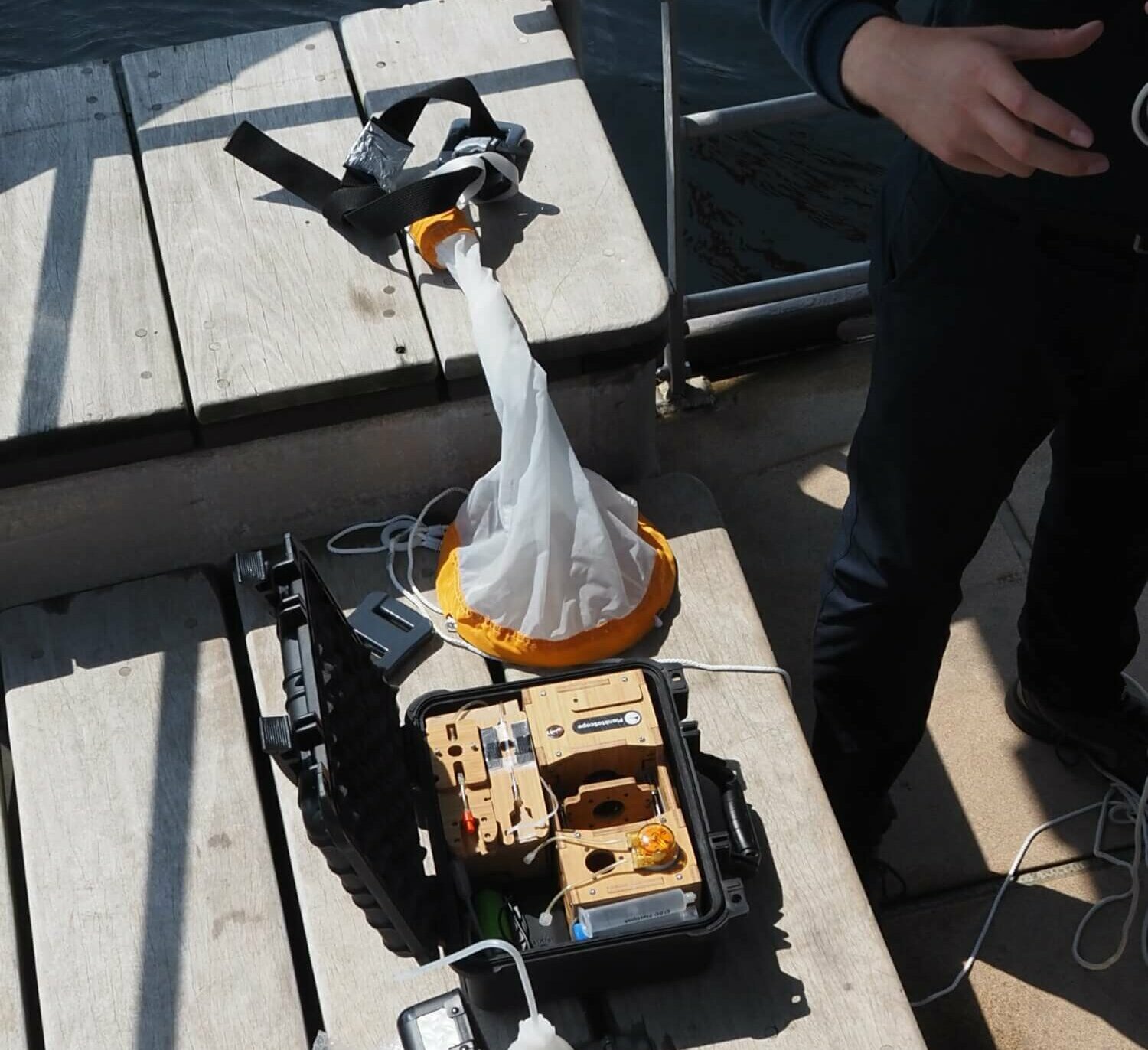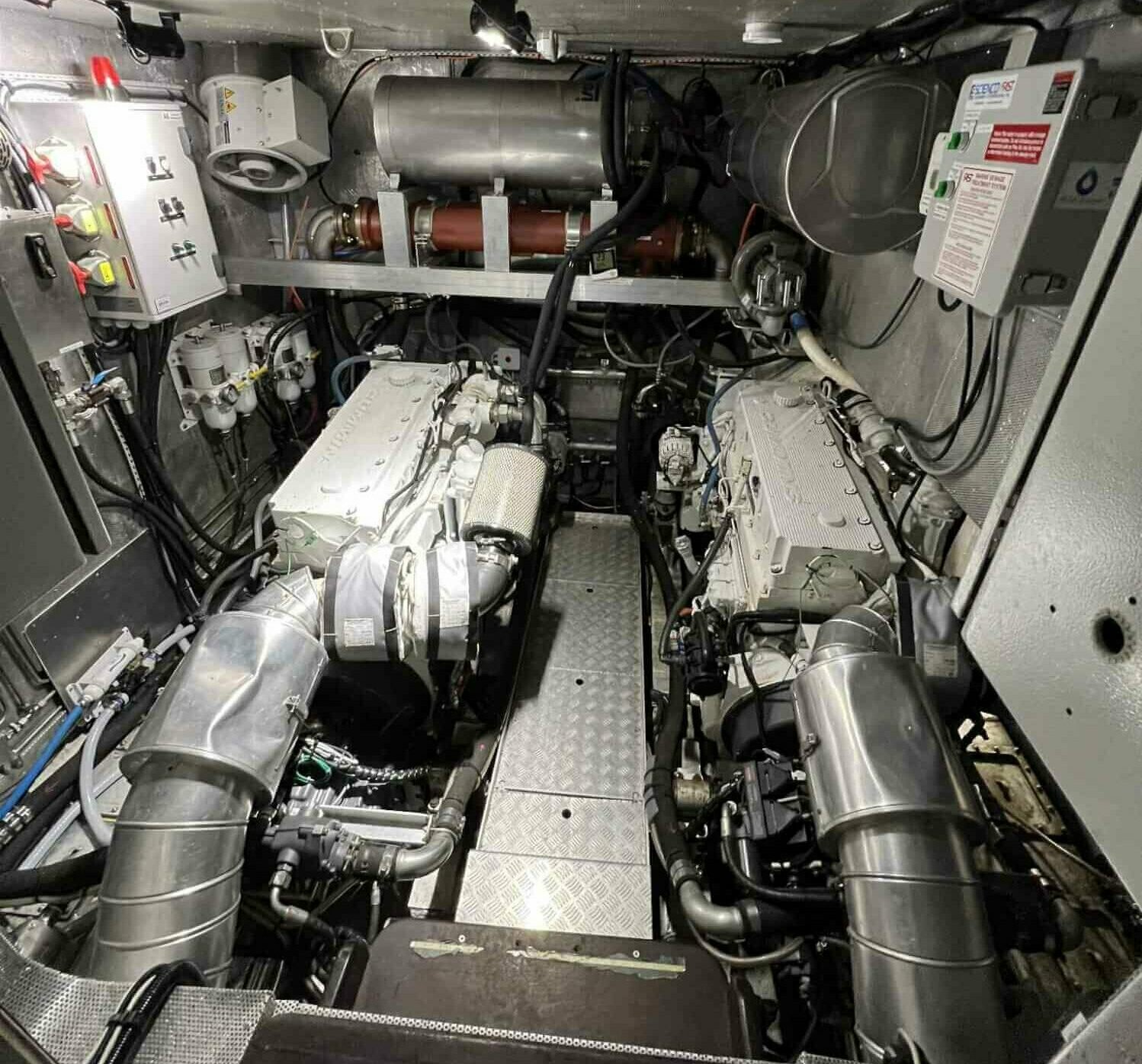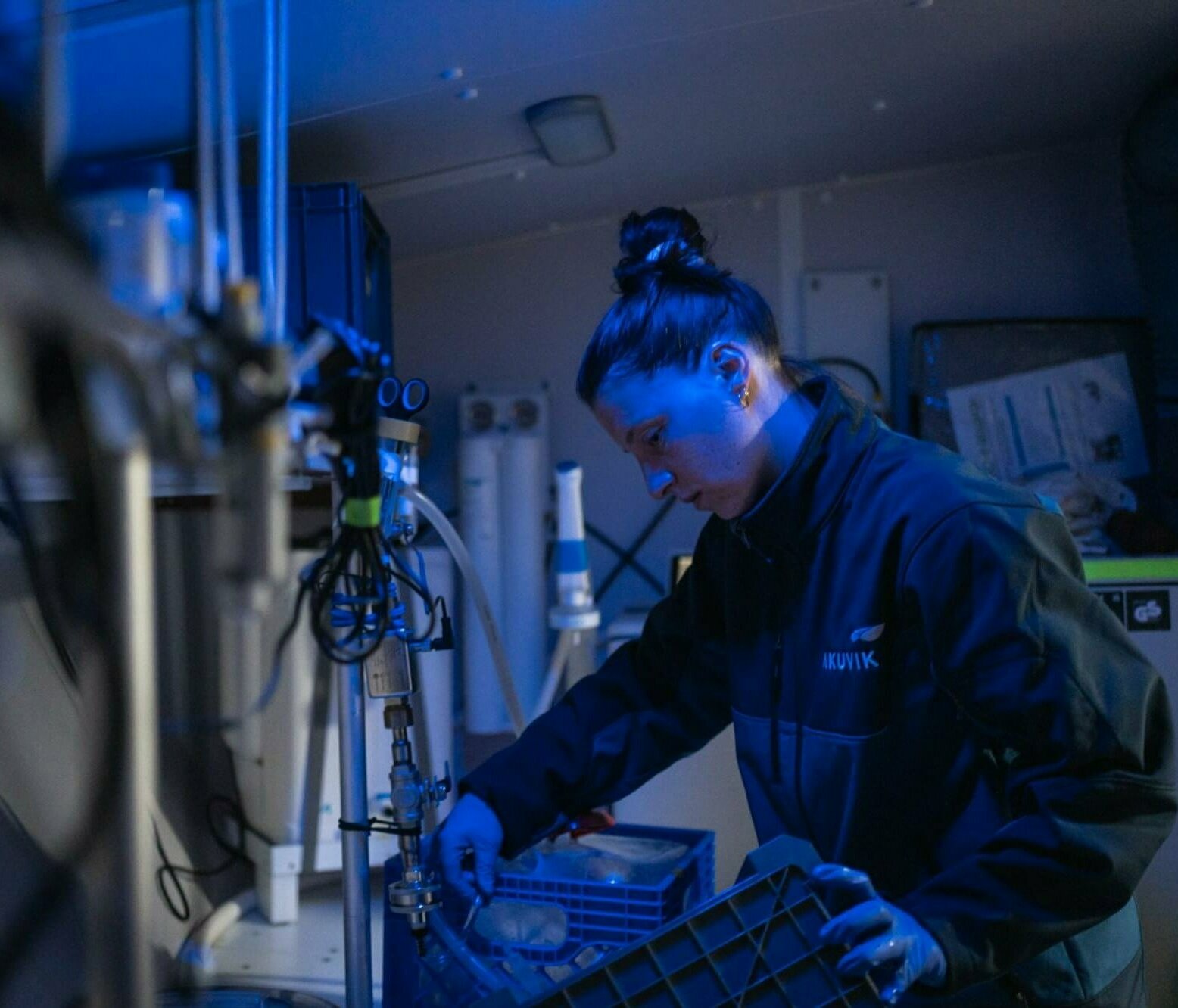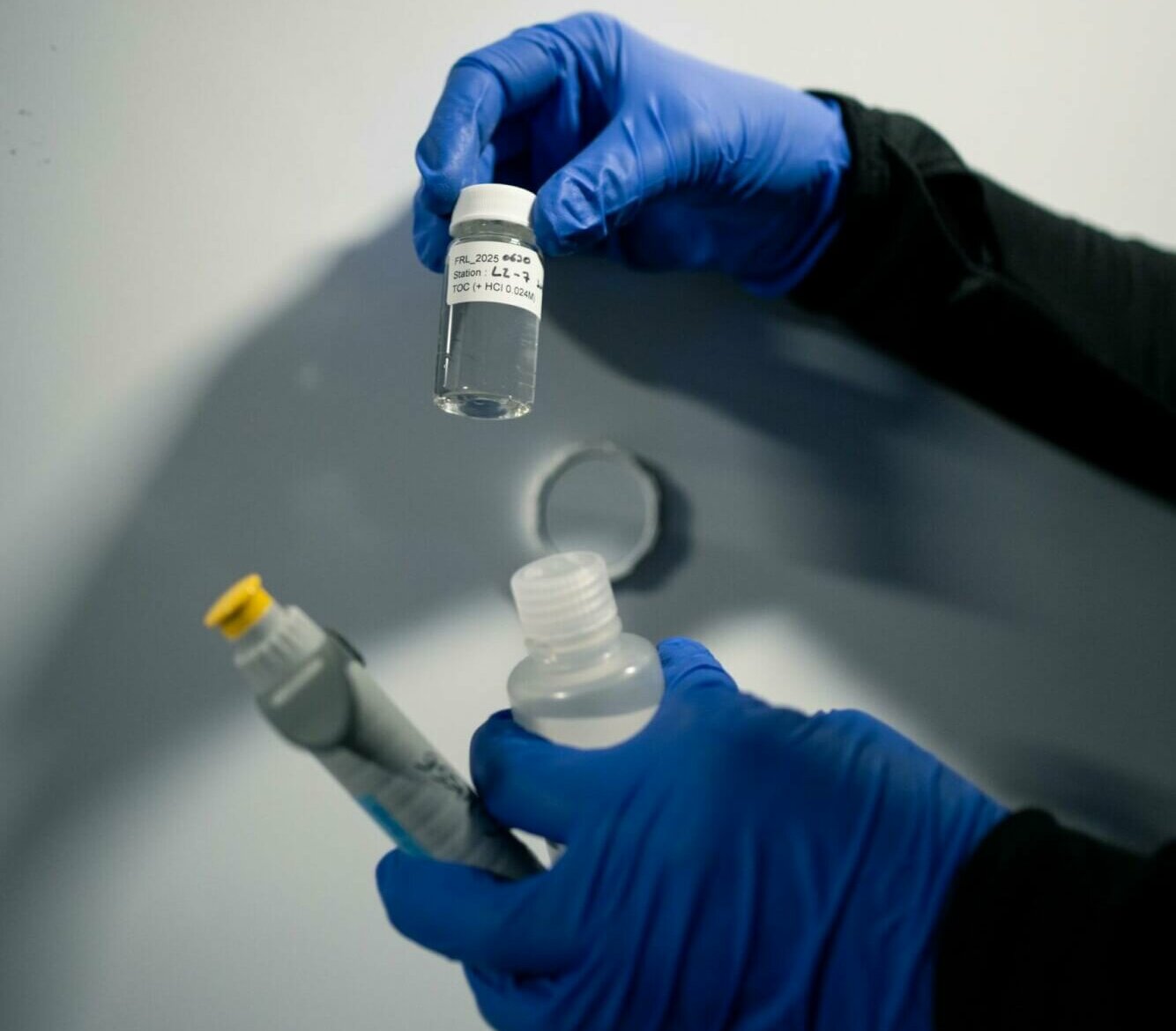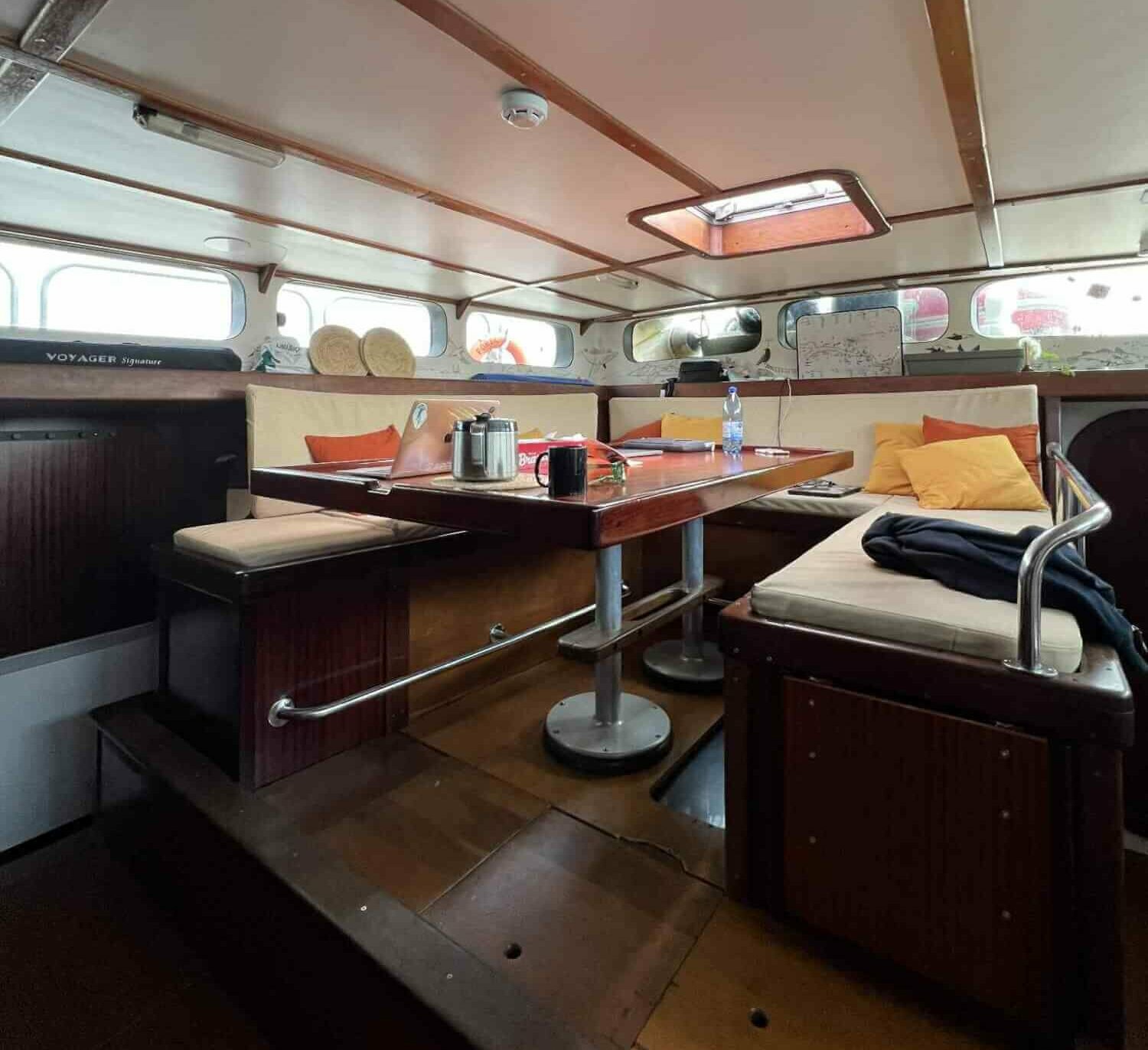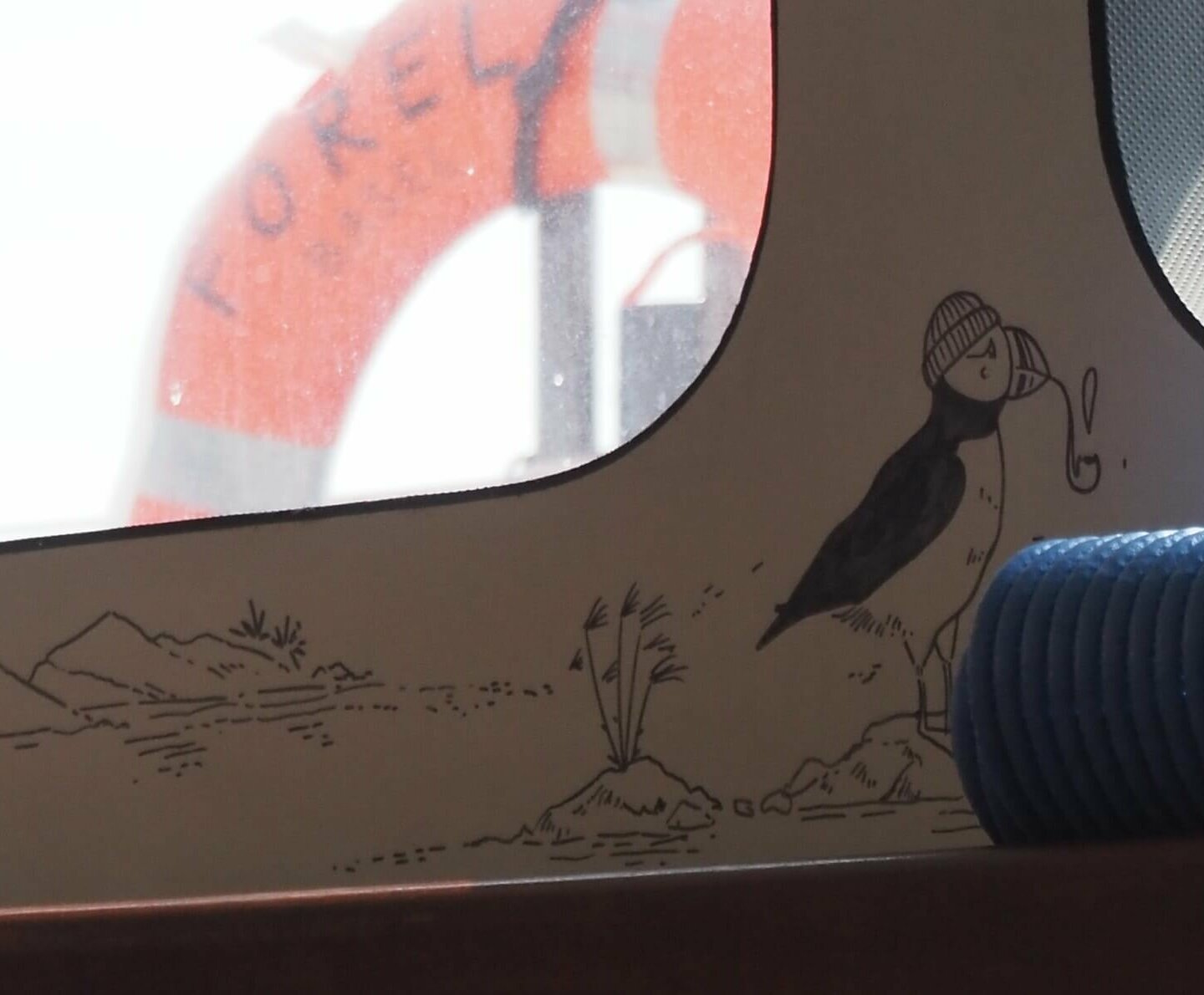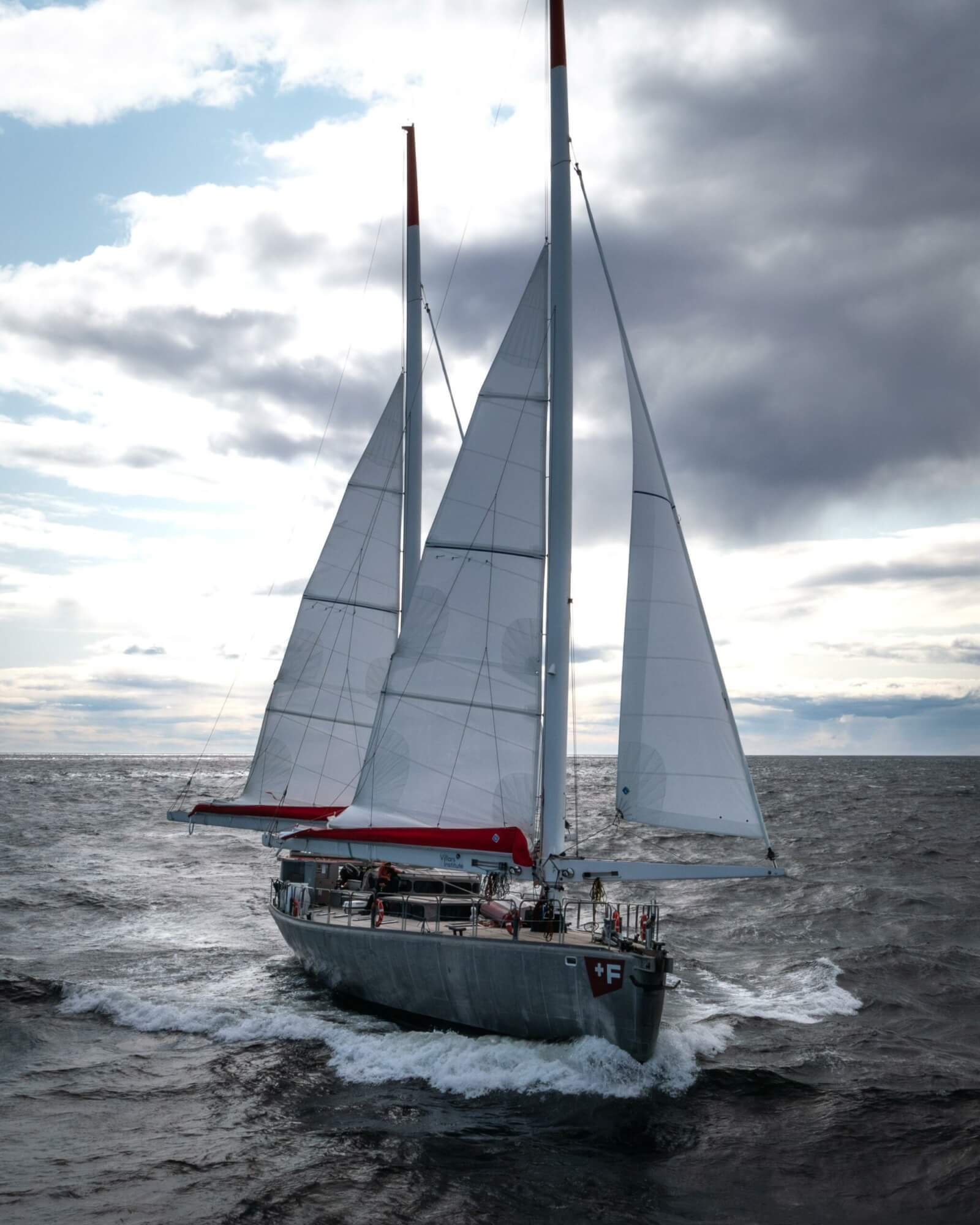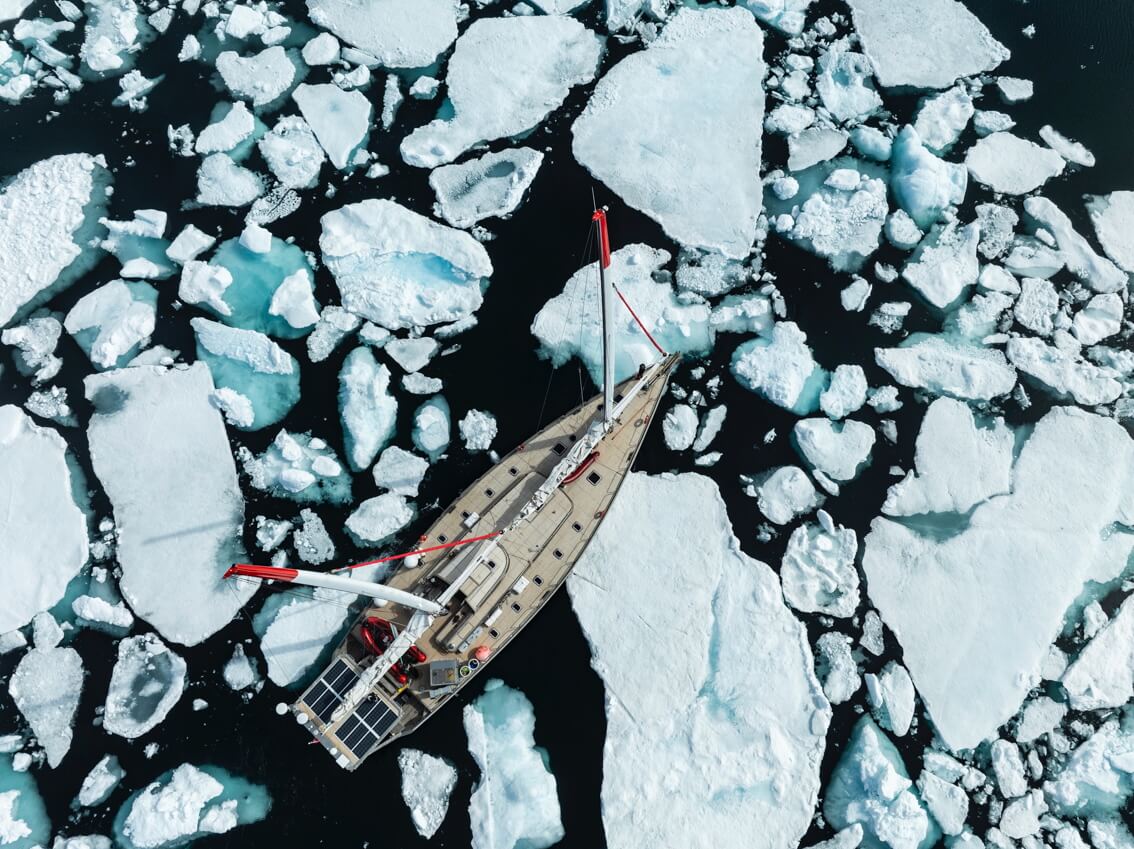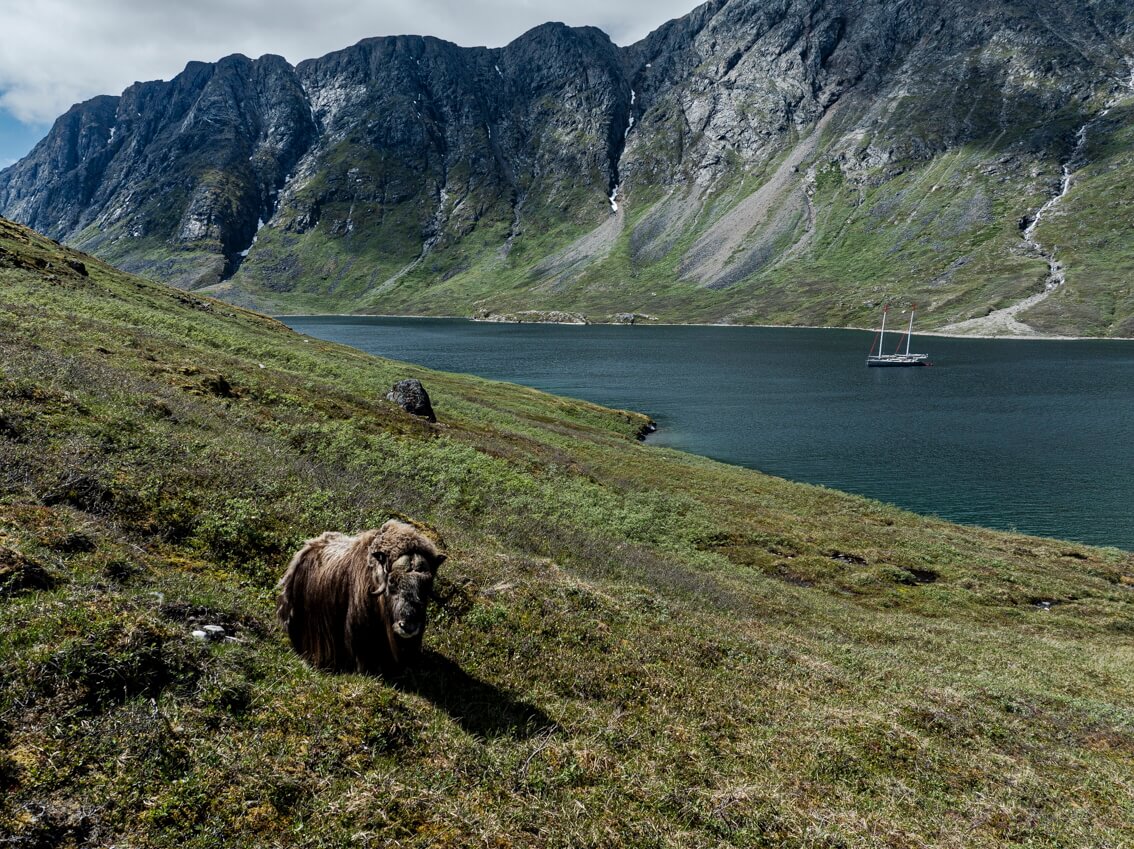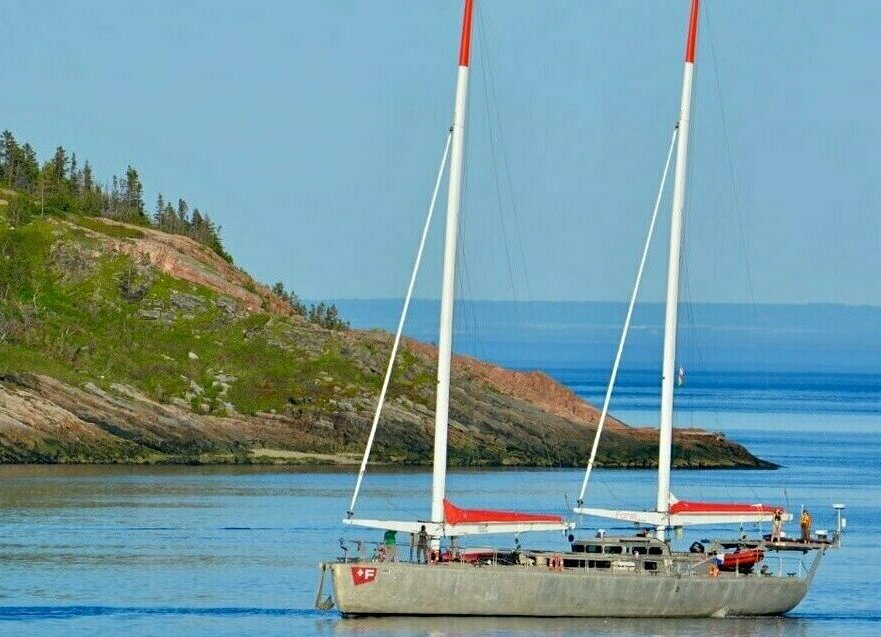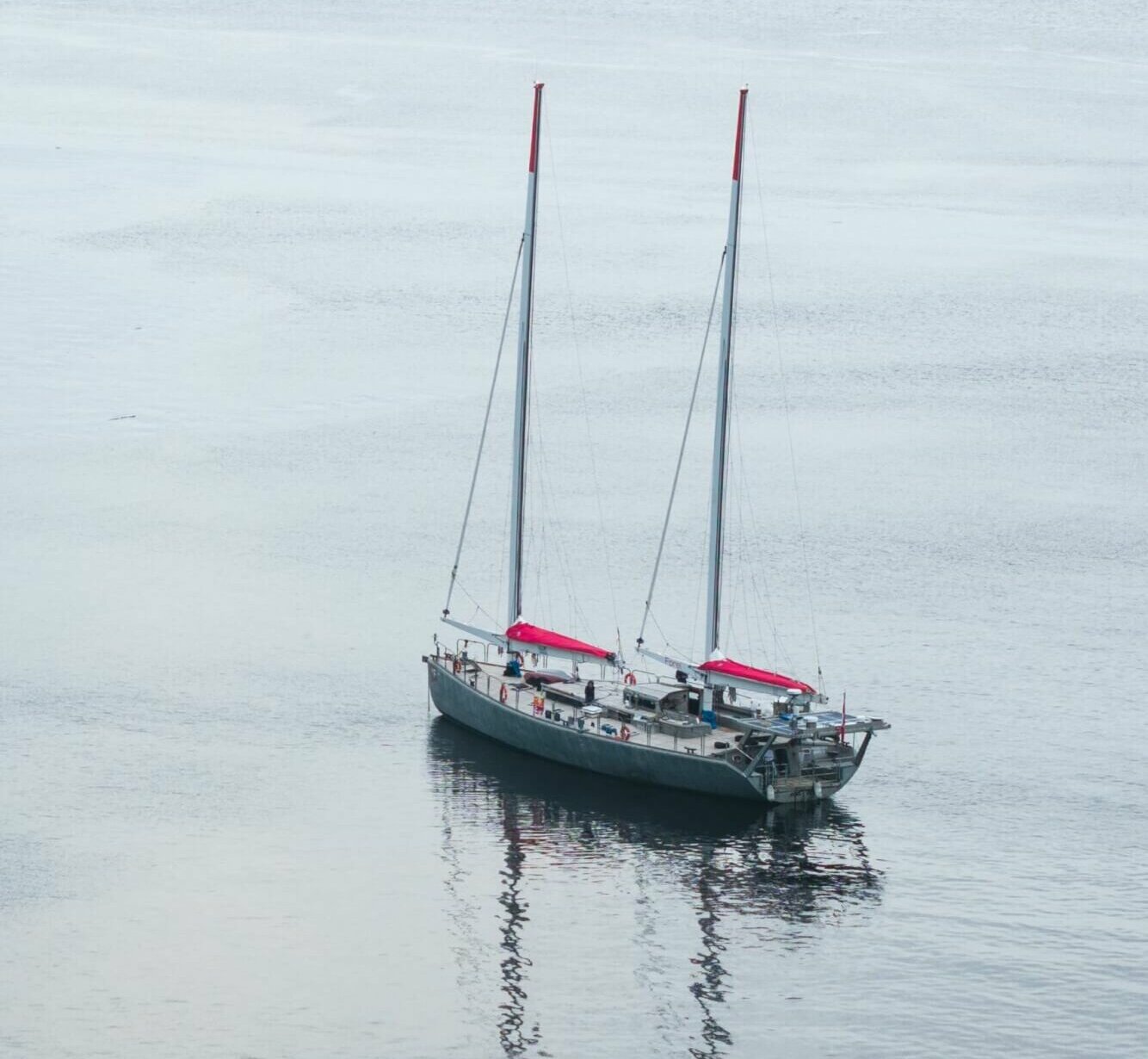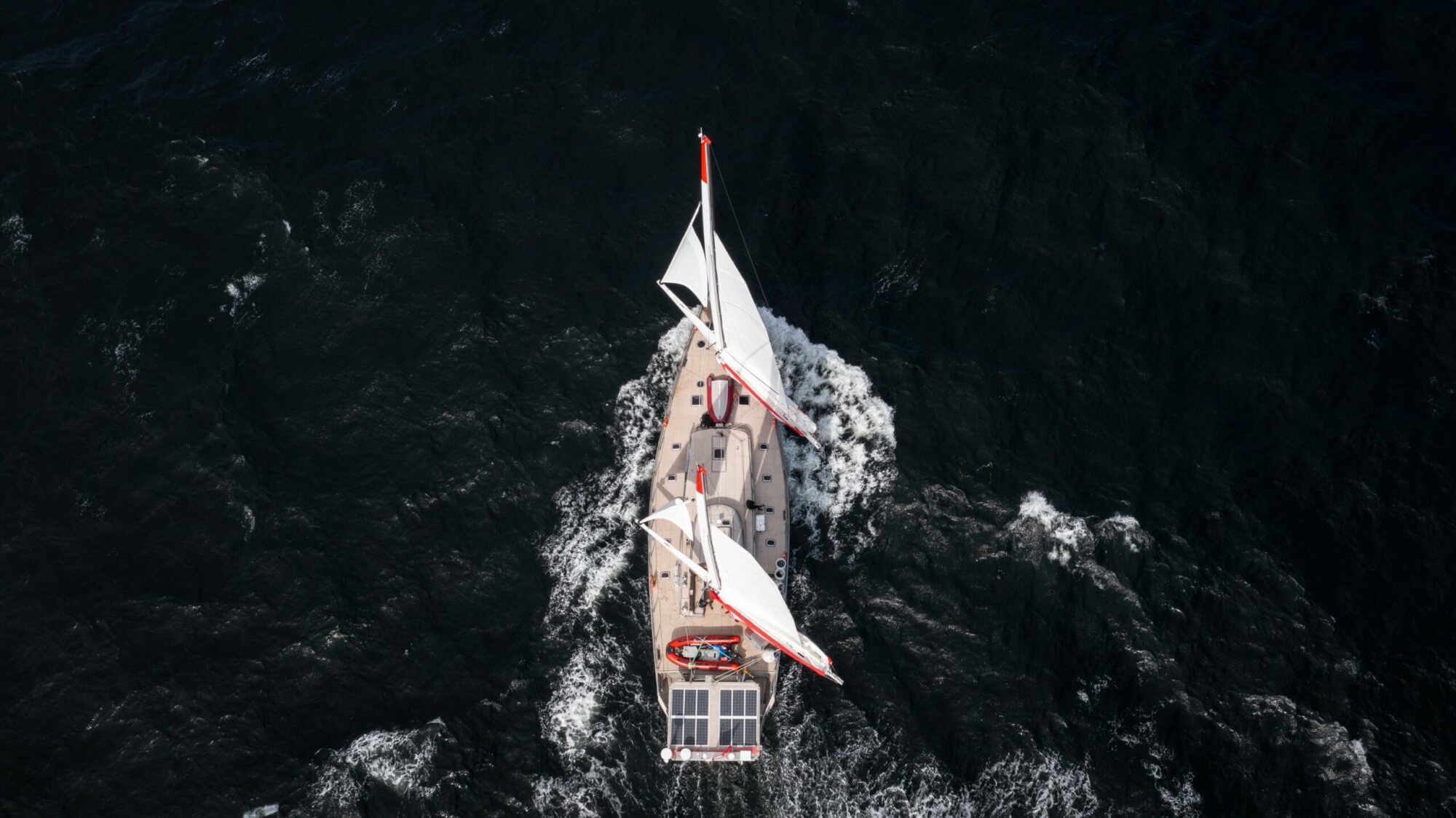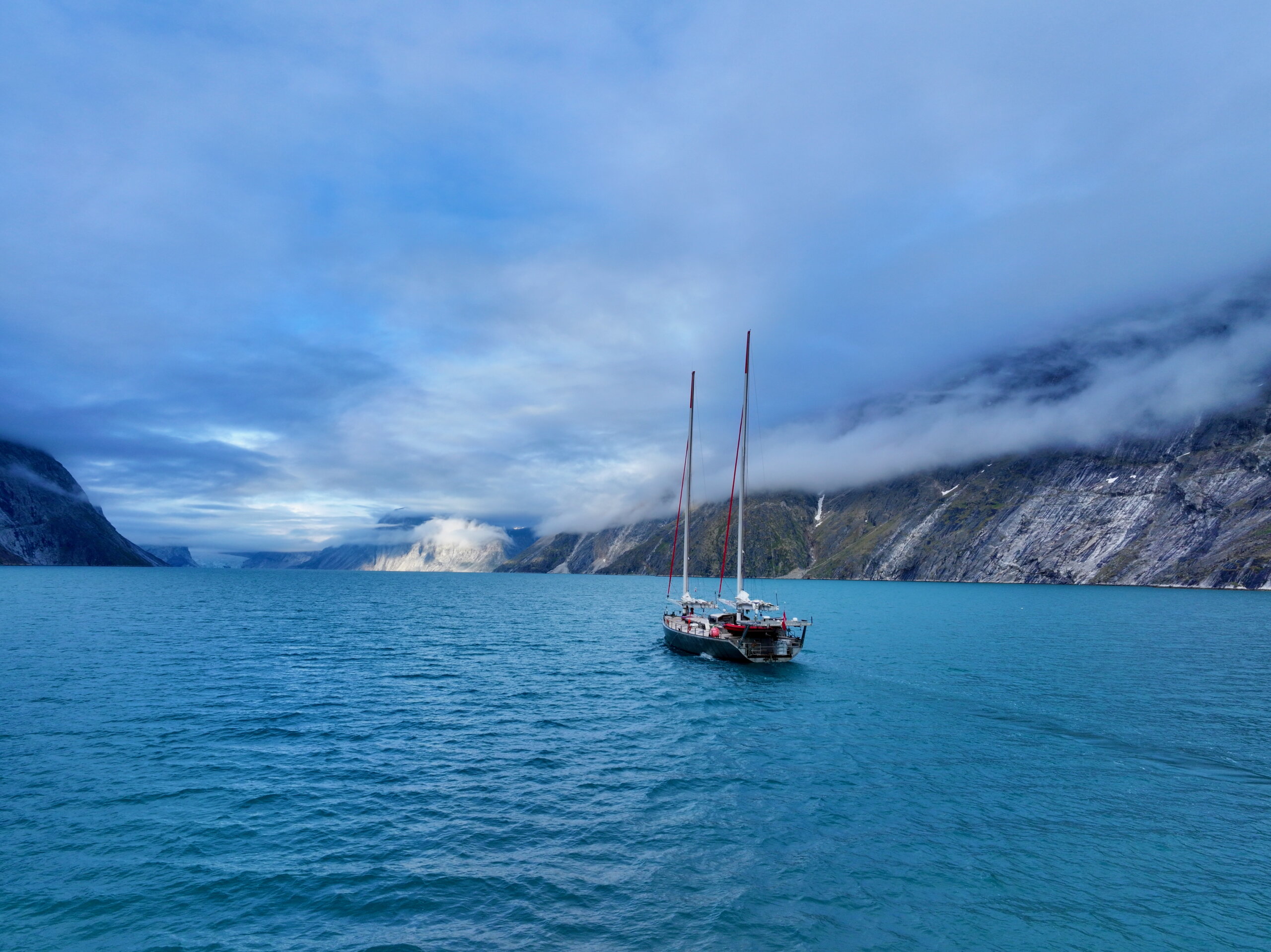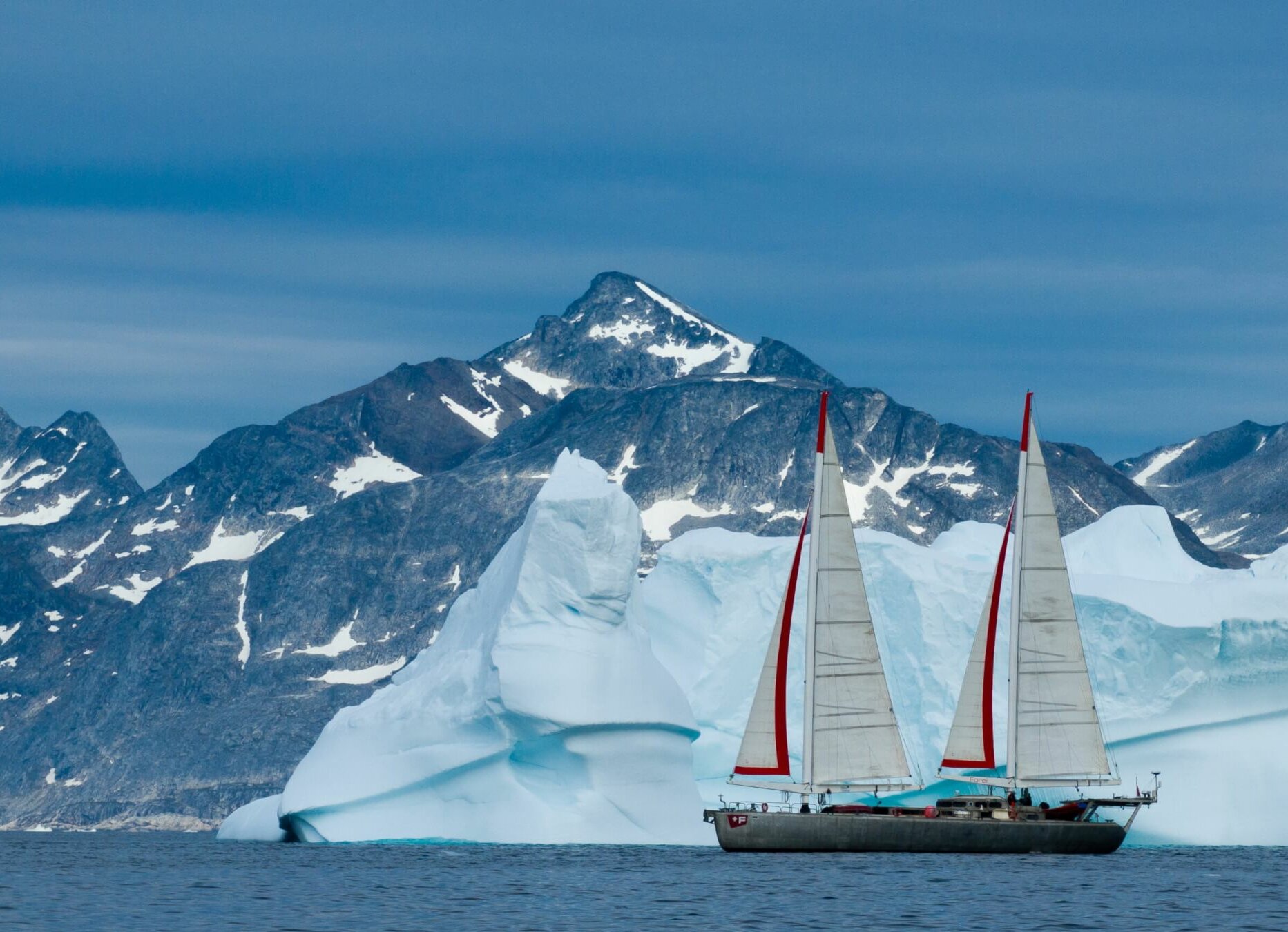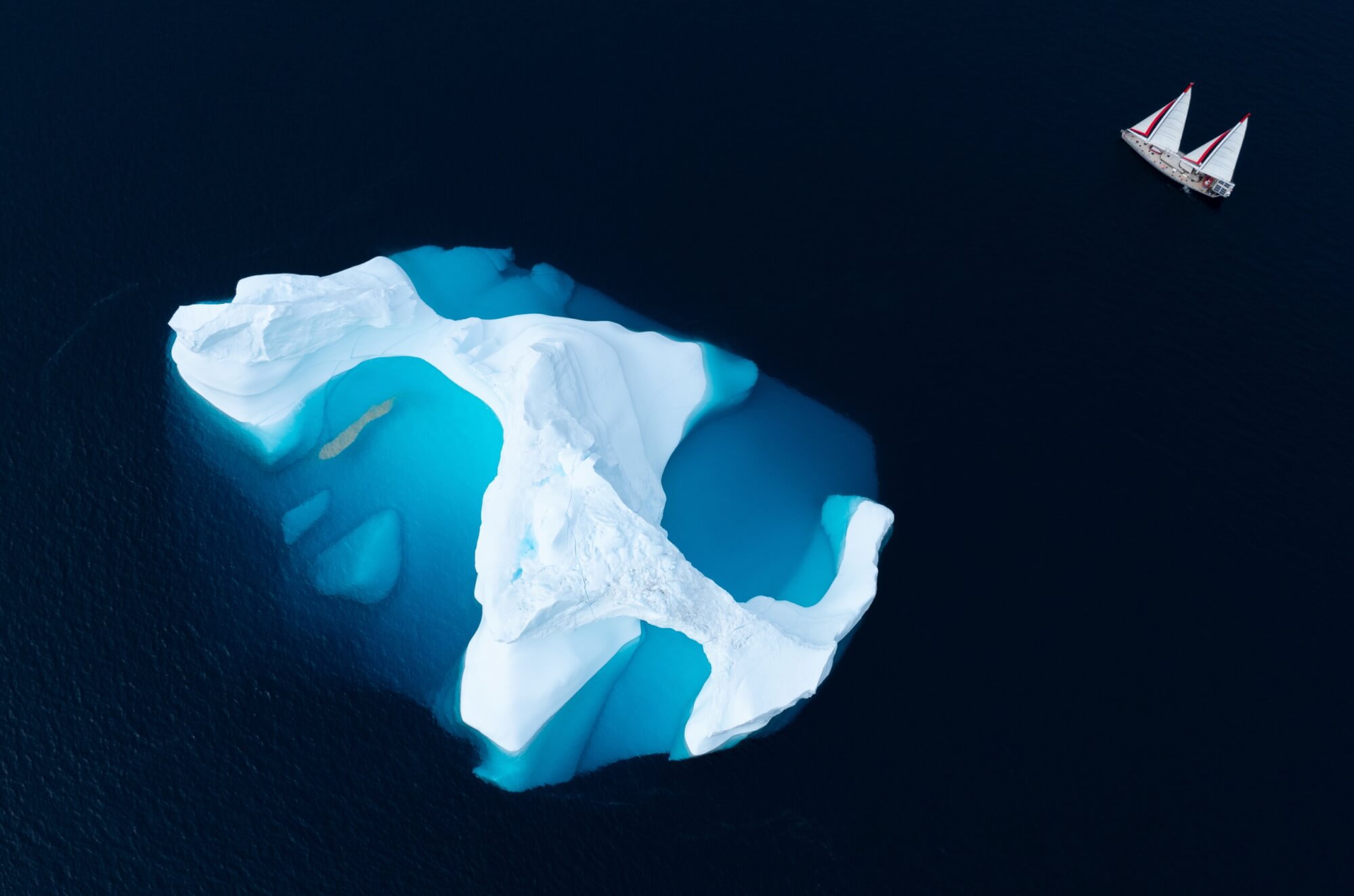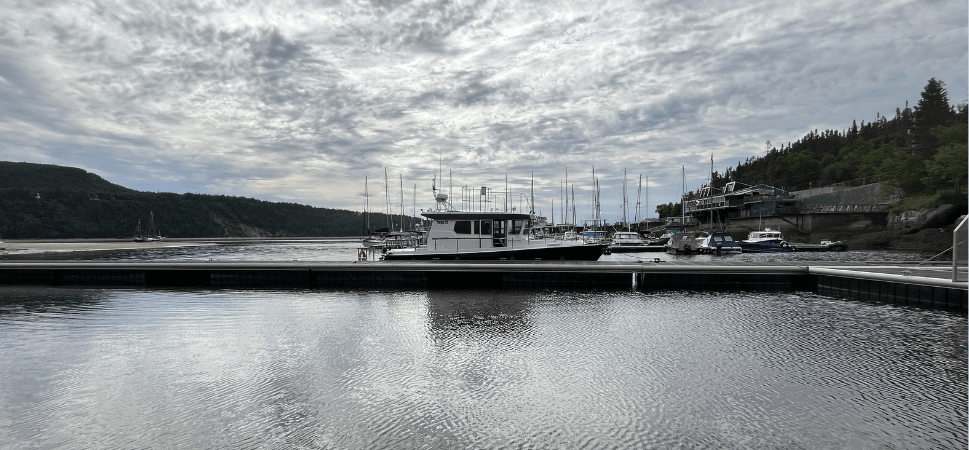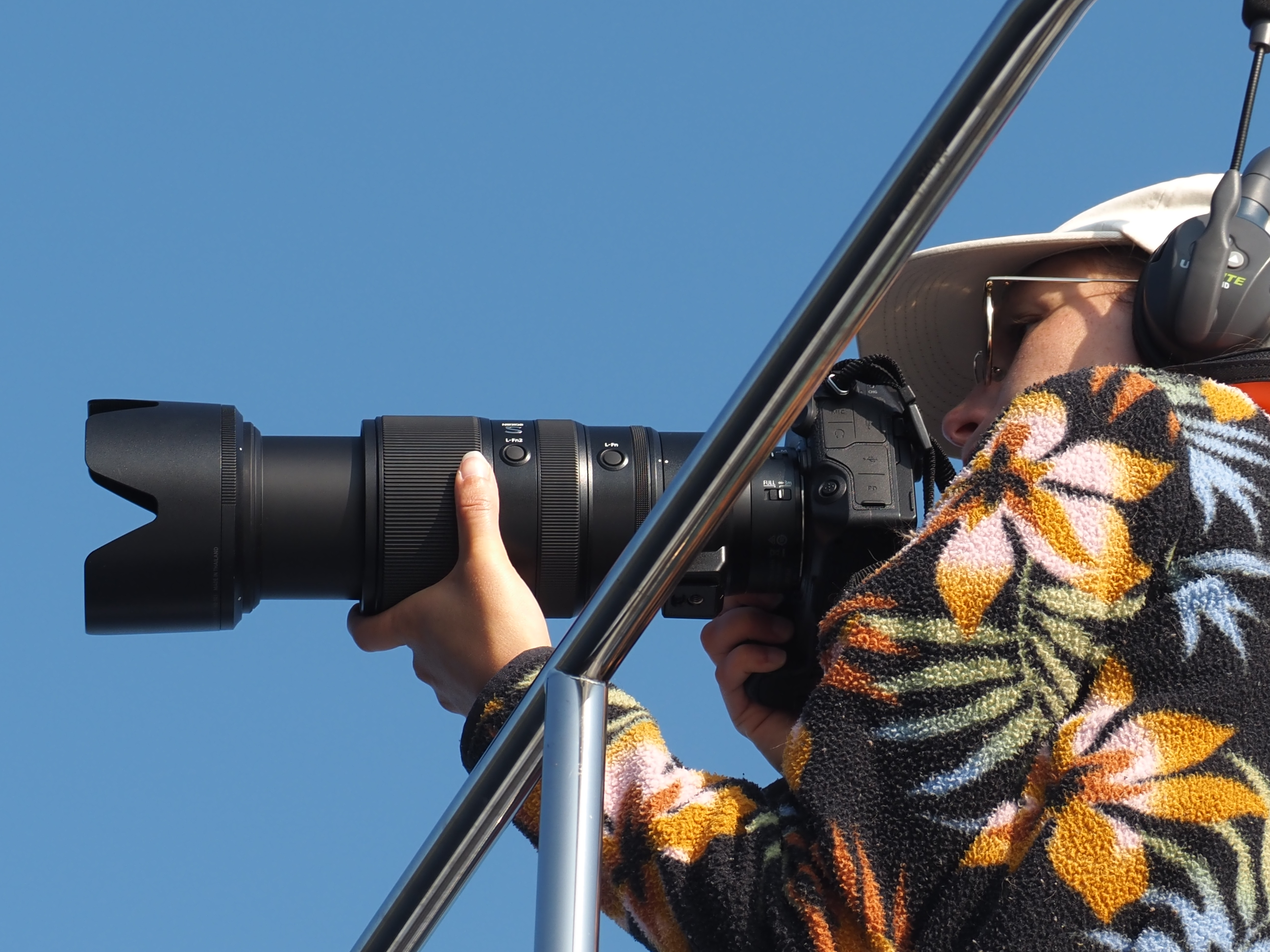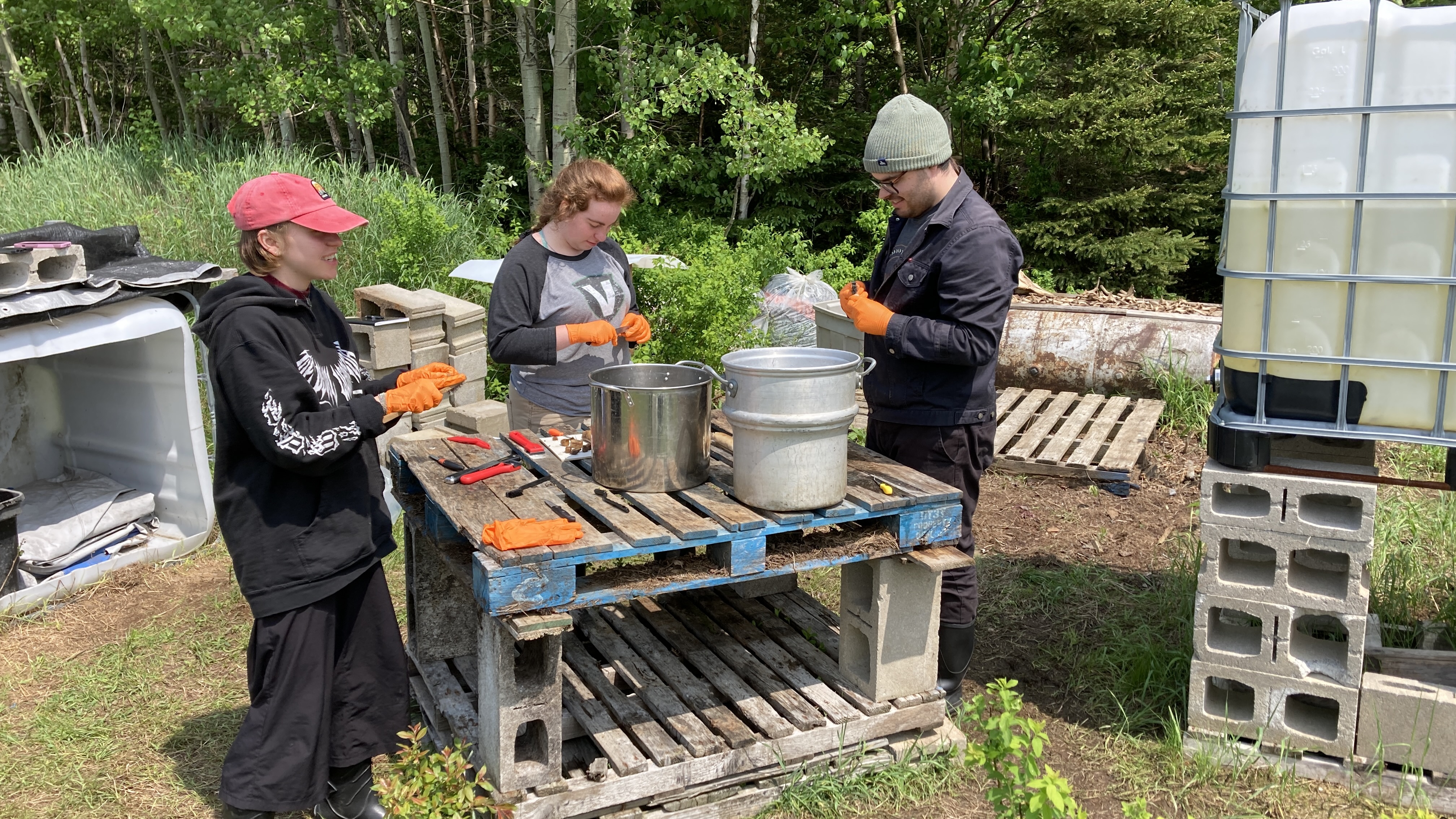We are two GREMM employees who had the privilege to board FOREL, a stately sailing vessel entirely dedicated to scientific research. The ship’s captain, Baptiste Régnier, picks us up at the dock in the tender to take us back to the sailboat, which is moored in Tadoussac Bay. The rain, which has been coming down in buckets since early that June afternoon, stops as soon as we set foot on board. In this field report, we invite you to explore this vessel and its mission, which goes far beyond the realm of science.
A Swiss sailboat in Quebec
The Swiss organization that manages this sailboat, Forel Heritage Association, is a new player in the field of scientific research and is currently conducting its second field season. In 2025, 140 days of missions for nine different research programs will be completed!
So, what is this gigantic sailboat doing here? After setting sail from Lorient, France, on May 19 and crossing the Atlantic, FOREL and her crew continued their expedition in the Saguenay Fjord. On board, a team of five scientists carried out various projects, analyzing water masses and plastic microparticles, amongst other things. Using a multibeam echo sounder to measure the depth and vertical walls of the Saguenay, researcher Vincent Lecours (bio in French) from Université du Québec à Chicoutimi aims to extensively map this little-known fjord.
Spellbound by FOREL
Returning to Tadoussac for a crew change, the ship anchored in the middle of the bay of this coastal village. It will later continue its expedition to Greenland. There, scientists will notably study the impact of melting glaciers on the ecosystems of Greenland’s fjords, methane emissions released by subglacial flows, and local perceptions of these changing fjords.
With its 28-metre-long hull topped by two immense masts, FOREL is in a league of its own. General Manager Stéphane Aebischer welcomes us for on board for a visit. On the vast aft platform is the rosette, a piece of equipment weighing over 100 kg that is used to collect water samples at specific depths. The heavy winch on the deck, together with its 1,500-metre cable, allows researchers to collect water in the desired conditions and at the desired depths.
Sleek on the outside, the boat is very different inside, and no space has gone to waste! Wet lab, dry lab, cleanroom airlock, engine room, galley, bathroom… Each space is dedicated to a specific task.
Scientists and students are calmly at work in the well-lit living space. Surrounding them is a mural depicting animals encountered during past voyages: muskoxen, puffins, narwhals, humpback whales, etc. A basil plant catches the light passing through the portholes. Alongside the breakdown of maintenance tasks are notes left by the crew members, testimony of an epic journey like no other. Everyone goes about their business, and no one interferes with this well-timed choreography.
In terms of energy, the boat runs primarily on diesel. A necessary concession for the crew, as the winch and the desalinator (or “watermaker”) have significant energy requirements. Solar panels line one of the aft deck platforms and power other less energy-intensive equipment, including washing machines, refrigerators and freezers.
A sailboat with all the bells and whistles
What makes this sailboat stand out as a research platform? Supported by two keels for good flotation, FOREL is designed to impress. Both its rudder blade and centreboard (which prevents the boat from drifting sideways due to the wind) are retractable. This allows the sailboat to sail in very shallow waters with a draught of 2.33 metres! Its two masts – which have no ropes, shrouds or stays – rotate on their own axis to follow the movement of the sails. These features, combined with two engines for superior manoeuvrability, enable FOREL to sail very close to the coast. This is one of the reasons why this sailboat focuses its research projects on polar and subpolar coastal areas.
Shared research
FOREL and her crew have a collaborative vision for research. In their contracts, scientists have a maximum two-year embargo on their data before they become publicly accessible. The crew is also collaborating with the St. Lawrence Global Observatory (SLGO), whose navigation tool (consisting of wind and current modelling down to the hour) they have found particularly useful! Surface water data collected using the “FerryBox” will be shared free of charge with SLGO. A fine example of collaboration!
FOREL’s strengths: Education and sharing
In addition to these technological features, FOREL’s mission goes beyond pure research. During its ports of call, the association places a strong emphasis on bolstering its ties with Indigenous communities in the regions it studies. During their next stop in Uummannaq, Greenland, sailors and scientists will meet with community members and the Uummannaq Polar Institute to explain their research projects and organize tours of the boat. The organization notifies communities when it is due to arrive and is active on social media to share the results of its work.
Building trust takes time, but during its first expedition in 2024, the crew developed a good rapport with the communities of Greenland. The result was a comic strip chronicling the various research projects, which has since been translated into English and Greenlandic! In Narsaq, in southern Greenland, “We organized a kaffemik with the elders during which we shared muktuk and Swiss raclette!” shares Stéphane Aebischer with a hint of nostalgia in his voice.
This cultural approach brings a breath of fresh air to the field of scientific research. “We’re not in our own country,” maintains Mr. Aebischer, “just like if Greenlanders came to Switzerland to take measurements without saying anything to anybody, we too would be asking questions.” This innovative approach is rooted in open-mindedness and the value of sharing.
Wintering in the Saguenay?
The association certainly has a Nordic flair. Director Stéphane Aebischer has worked in Quebec at the Centre for Northern Studies, as well as with the organizations Takuvik, , and . He has also participated in polar expeditions on the research sailing vessels ATKA and TARA.
With its eyes on the Arctic and Antarctic, the crew is currently interested in training for a winter expedition in which they would let the boat get trapped in the ice to spend the remainder of the season on board. The fjord is a potential candidate for this mission, which would not only have a scientific purpose, but would also allow the vessel and crew to test their ability to withstand extreme conditions. In theory, this sailing vessel could have an autonomy of about two months. FOREL is designed to endure icy conditions. It even has a heater that can maintain a temperature of 15°C inside even when it’s -20°C outside. All you need is a sweater!
FOREL hasn’t said her last word
Will FOREL ever return to our waters? In any case, “There is interest from Canadian researchers,” notes Stéphane Aebischer, and a need to study this still little-known ecosystem. How can we explain this data gap in the Saguenay Fjord? Hard to say, but he notes that there is “a real lack of this type of mobile research platform in the region.” The research interest is certainly there, and, for the association’s director, there is currently a real awareness: “People are increasingly interested in the fjord and realize what a beautiful ecosystem it is.” The association is apparently ready to conduct research on marine mammals, and the vessel’s low noise emissions bode well for the use of hydrophones.
The visit comes to an end. Between the jokes and the smiles on the faces of the scientists (newly arrived on board and electrified for the upcoming adventure), we can sense a . The partly renewed crew is busy preparing for its departure for Blanc-Sablon, the final port of call before it sets sail for Greenland. There’s still a great deal of work to be done.
We return to the marina with some of the crew members whose adventure also ends here. FOREL looks as imposing as ever, and we will see it leave the bay at the crack of dawn, en route to the Far North. Hats off to an innovative project that is breathing new life into research in Canada.
Let’s wish them fair winds and following seas!


